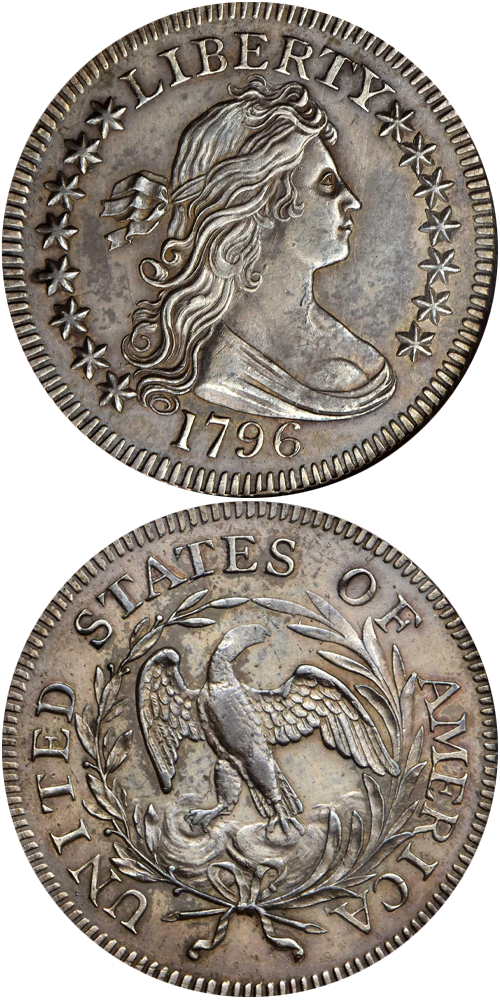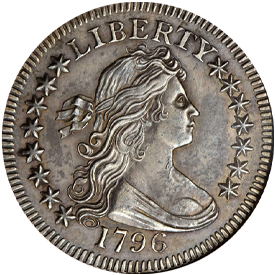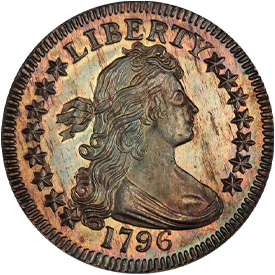Designed by: Robert Scot
Issue Date: 1796
Composition: 89.24% silver, 10.76% copper
Diameter: 27.5 mm
Weight: 6.74 grams (104.01 grains)
Edge: Reeded
Business Strike Mintage: 6,146
Proof Mintage: None
Like dimes, quarter dollars were not minted until 1796, at which time the Draped Bust obverse style was employed. The obverse features Miss Liberty facing right, with flowing hair and a ribbon behind her head, with drapery covering a plunging neckline. LIBERTY is above and the date 1796 is below. Eight stars are to the left and seven to the right. Around the border are prominent denticles. The reverse has an open wreath tied with a bow at the bottom, enclosing a small eagle perched on a cloud. UNITED STATES OF AMERICA surrounds. There is no indication of value or denomination.
Examples of 1796 quarters are found in all grades, with those from About Good to Fine being most often seen. Probably several hundred survive. Very Fine coins are scarce, Extremely Fine pieces are scarcer yet, and AU or better examples are seldom met with. A number of 1796 quarters were made with prooflike surfaces, such pieces occasionally being called Proof in sale catalogues, although it is not known whether they were specifically made as such. Several dozen prooflike coins exist today. The sharpness of strike on most 1796 quarters encountered is apt to be decent, much more so than on the following design type. An exception is the head of the eagle on the reverse, which is nearly always indistinct.
The 1796 quarter dollar is considered to be a key issue in any grade and is a landmark in the American coinage series.
Further Reading
Specimens of the quarter dollar denomination were first produced in 1796. Pieces of this year are doubly significant, for they represent the first year of issue as well as the only year with the Draped Bust obverse in combination with the Small Eagle reverse design. These characteristics, coupled with a low mintage (just 6,146 pieces), have made the 1796 quarter a great rarity. Specimens in all grades are highly desired by collectors today.
The term a great rarity is relative. Certainly, in the context of American design types the appellation is merited. However, a number of superb Uncirculated examples exist. In Coin World, October 30, 1968, Abe Kosoff told of an interesting group of 1796 quarter dollars from the Col. E.H.R. Green estate handled by Burdette G. Johnson, who seemed to make estates a specialty and also was involved with the dispersal of the Virgil Brand holdings. Kosoff related that James G. Macallister, the Philadelphia dealer, went to St. Louis to acquire a number of the Green pieces. From that point he went to New York City to visit Kosoff, who with Abner Kreisberg operated the Numismatic Gallery. In Abe Kosoff's words:
"When he [Macallister] reached New York City on his return trip he stopped in to see me at the Numismatic Gallery. Mac used to wear a homburg hat and a heavy overcoat. From one inside pocket, he took out a long package about 15 to 18 inches, narrow, in brown wrapping paper. On the show counter he unwrapped it and displayed row after row of 1796 quarters, every one Uncirculated. 'Ninety bucks, take your pick; he said. Before the 'wow' got out of my mouth, out of another inside pocket Mac took out another package, very much like the first. 'These will cost you $125 each; he advised. This group contained the so-called 'Proof' 1796 quarters, brilliant gems, each and every one. The first parcel contained the frosty coins. I don't really recall how many I bought, perhaps five or six of each. All in all I would say there were about 100 pieces, possibly a few more or less.”
In 1955 Aubrey Bebee, the well-known Omaha dealer, showed me a prooflike 1796 quarter and noted, almost apologetically, that he had paid $200 for it, a record price. At the time the 1796 quarter was not high on the list of American rarities. Type set collecting was in its infancy, and the primary demand came from numismatists who assembled quarters by date and mintmark sequence, of which the numbers were not legion. Twenty-five years later, when a similar specimen sold for $40,000 to a New York specialist, both Aubrey Bebee and Abe Kosoff may have smiled. But, as is the case with most dealers, they probably sold their holdings many years earlier.
1796 quarters, once fairly plentiful in Uncirculated grade, are seldom seen today. In the present market a single prooflike Uncirculated piece would, if offered in one of our auction sales, merit a very enthusiastic description along with enlarged illustrations. The number of collectors has multiplied many times during the 1950s, and what was once easy to find is now quite elusive.
Most 1796 quarters display weak striking on the eagle's head. The features of the eagle's head seem to blend into the field, with little distinction of the eye and beak. Robert Amel, the New York numismatist who put together a beautiful type set in the 1960s, once told me he had spent several years looking for a 1796 quarter but had not found one that was just right so far as striking was concerned.
Quarters of this date are encountered in all grades. Uncirculated pieces nearly always have prooflike surfaces. Discounting the fantastic hoard described by Abe Kosoff, a group which has largely disappeared (perhaps it will come to light in some future year to dazzle numismatists), there are probably no more than 50 to 100 other Uncirculated examples in existence. Some of these have been called Proofs. Walter Breen in his Encyclopedia of United States and Colonial Proof Coins has written of nearly ten 1796 quarters which he believes to be special presentation pieces or early day Proofs, noting that “many others are known on planchets showing some degrees of polish before striking, but they do not qualify as presentation pieces because striking is weak or uneven…”
In other states of preservation, quarters can be found from About Good through AU, with the most often seen grades being in the lower range. Sharp Extremely Fine and AU examples are elusive. The particularly prominent border denticles (toothlike projections at the edge) on this issue and the high rim seem to protect the features from wear, with the result that even extremely worn pieces are apt to have a bold date.
In keeping with certain other United States series, the 1796 quarter bore no indication of denomination. The first gold and silver issues of the United States Mint were accepted by the public on the basis of their apparent diameter, weight, and metallic value.








